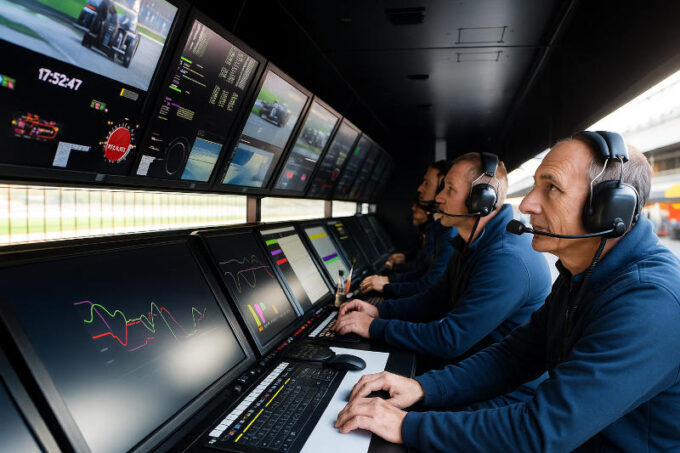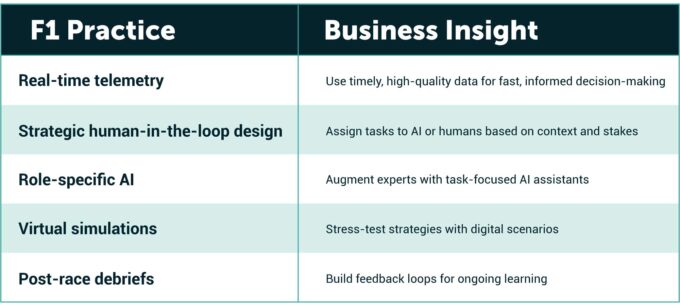
2026 AI trends: What leaders need to know to stay competitive
Is your organization AI-ready? IMD professors and researchers predict 2026 trends in artificial intelligence. Read on and prepare to innovate – or be left behind. ...

by Konstantinos Trantopoulos , Paolo Aversa Published July 25, 2025 in Artificial Intelligence • 9 min read
This is the first in a series of articles exploring strategic insights for business leaders from the world of sports.
Formula 1 has rapidly evolved into a global entertainment powerhouse, boasting a fan base of around 826 million, a 12% increase year-over-year, with notable growth in key regions like China (+39%) and the US (+10.5%). The sport’s commercial momentum reflects this surge, with annual revenue climbing for the fourth consecutive year to US$3.65 billion in 2024. A major catalyst has been Netflix’s Drive to Survive, the breakout docuseries credited with reinventing the sport’s public image. With over seven million viewers globally—nearly a third under 30—it has been a marketing triumph, helping attract younger, more diverse audiences, particularly women and Gen Z, who now engage with content daily and turn races into cultural events.This surge in fandom has coincided with Hollywood’s latest embrace of F1-themed storytelling. Apple’s blockbuster F1: The Movie, starring Brad Pitt, debuted on 27 June and has already grossed around $293m worldwide, marking the studio’s most successful theatrical release to date and Pitt’s career-best opening.

Formula 1 is one of the most advanced real-time data and AI environments in the world, where competitive advantage increasingly comes from bytes and algorithms as much as from driver skill or engine power. Today’s Formula 1 teams capture massive volumes of real-time telemetry thanks to the 300-600 sensors embedded in each car, measuring everything from engine temperatures, tire pressure, brake wear, and aerodynamic loads.
During a typical race weekend, a single F1 car can generate hundreds of gigabytes of data (teams report ~400 GB per car per race in recent years), and including high-speed video and other datasets, total data per car can approach 1 terabyte over a full racing weekend. All this information is streamed via a high-bandwidth telemetry system, allowing engineers at the track and at remote factories to monitor and analyze car performance in real time. By 2025, nearly every Formula 1 team has forged deep collaborations with leading tech companies, including Microsoft, Oracle, AWS, Google, Dell Technologies, AMD, Palantir, and Neural Concept, leveraging cloud infrastructure, AI, and real-time data analytics to run billions of simulations, accelerate car design, optimize race strategy, and gain competitive edge in an increasingly data-driven sport.
This creates an unparalleled testing ground for AI applications in high-stakes, high-speed environments. As a result, F1 teams have evolved into elite decision-making units that balance machine precision with human judgment. These dynamics offer critical lessons for organizations grappling with how to integrate AI into human workflows.

Formula 1 teams rely heavily on advanced telemetry and AI to gain a competitive edge. Modern F1 cars stream over a million data points per second via hundreds of onboard sensors, and cloud computing platforms such as Oracle Cloud process this flood of information to run billions of real-time strategy simulations. These simulations factor in dynamic variables like weather, track temperature, and tire degradation to help determine optimal race strategies. AI-driven dashboards distil this complexity, surfacing only the most actionable insights to engineers, guiding decisions like when to pit or how to adjust a driver’s pace to manage thermal and mechanical stress.
Beyond race strategy, AI models enable predictive maintenance by analyzing historical and live telemetry data to anticipate component failures before they happen, often making the difference between a podium finish and a DNF (Did Not Finish) due to mechanical breakdown. Some teams even use generative AI during races to parse hundreds of pages of FIA (Fédération Internationale de l’Automobile) sporting and technical regulations, extracting relevant clauses in seconds to ensure compliance or identify strategic loopholes. Historically, dedicated engineers were burdened with the demanding task of analyzing thousands of pages of intricate regulations and assessing numerous past incidents to make rapid, race-defining decisions.
Yet despite this digital horsepower, F1 teams don’t hand full control over to machines. Human engineers remain central to interpreting AI outputs, applying domain expertise and situational judgment to override or refine algorithmic recommendations. To support this balance, Formula 1 teams delegate continuous monitoring and predictive diagnostics, such as spotting brake imbalance or anticipating tire degradation, to AI, since these tasks are data-heavy, time-sensitive, and cognitively overwhelming for humans in real time. In contrast, decisions around race strategy, pit stop timing, or rule interpretation often involve ambiguity or legal implications. Here, humans stay in the loop to apply domain expertise, intuition, and situational judgment to override or refine AI outputs, ensuring context and discretion. It is equally important that humans receive the right information at the right time, without being overwhelmed with unnecessary detail or left under-informed. F1 demonstrates that optimal decision systems are hybrid by design, leveraging AI for speed and scale while relying on humans for nuanced interpretation and strategic decision-making.
This human-in-the-loop model aligns with research that highlights how even the most sophisticated AI tools in Formula 1 can underperform or mislead when their sociotechnical context is ignored. Failure often arises not from flaws in the algorithms per se, but from the misalignment between AI outputs and human interpretative practices, a reminder that synergy depends not just on performance, but on relational understanding.
This collaboration between human intuition and AI precision illustrates a core principle in F1: peak performance arises not from full automation, but from augmenting human decision-making with intelligent systems.
AI tools are embedded to enhance performance through task-specific support, not general automation.
At the heart of every F1 team is a deeply structured, role-specific organization. AI is designed to support, not replace, these roles. Pit crews use pose-estimation AI to optimize movements and minimize time loss during tire changes, often completing stops in under two seconds. Simultaneously, engineers rely on AI to monitor components and alert the team to hidden issues such as brake imbalance or power unit stress.
Drivers train in hyper-realistic simulators powered by AI to test responses to rare but critical race scenarios like sudden weather shifts or virtual safety cars. These simulations aren’t static; they’re continually updated with real-world race data, making them powerful preparation tools.
Post-race, F1 teams run structured reviews where engineers, strategists, and drivers analyze how AI predictions compare with real outcomes. These learning loops refine both human decisions and machine models, reinforcing each role’s ability to perform better over time.
In every role, AI tools are embedded to enhance performance through task-specific support, not general automation.
F1 teams reconfigure their business models to thrive under technological and regulatory constraints.
In a sport defined by strict budget caps and limited resources, AI enables smarter, faster decision-making. Formula 1 teams use AI to triage simulations, prioritize resources, and streamline testing schedules. Instead of running every potential design tweak through a wind tunnel, teams simulate digital twins in the cloud to efficiently assess aerodynamic performance.
These optimization strategies mirror broader shifts in how F1 teams reconfigure their business models to thrive under technological and regulatory constraints. In this light, AI is not just a technical enabler, it’s also a strategic asset for resource allocation, helping teams navigate cost caps and engineering limits with precision.
AI also plays a critical role in safety. Continuous telemetry monitoring allows real-time detection of anomalies, such as excessive tire wear or battery overheating. In some cases, AI systems can alert race control or team engineers before a critical failure occurs.
This fusion of performance and protection illustrates how AI-driven automation serves both productivity and safety. The same principle applies in business settings, where AI and cybersecurity intersect to form a proactive defense system. AI continuously monitors for threats, scanning for anomalies and flagging potential breaches before they escalate. Just as in F1, rapid detection and response are critical, turning AI into both a shield and a competitive edge in managing operational risk.
The F1 model offers a valuable playbook for industries navigating real-time data and AI. Here are five core strategies that can be transferred to other sectors:

F1 shows that peak performance comes not from replacing humans with machines, but from designing systems where each strengthens the other.
F1 shows that peak performance comes not from replacing humans with machines, but from designing systems where each strengthens the other. Success depends on how well teams can interpret signals, adjust in real time, and learn from every outcome, and on knowing exactly when to bring humans into the loop and when to delegate to AI for speed, scale, and precision.
As businesses accelerate into a future defined by algorithmic speed and constant complexity, the takeaway from Formula 1 is simple but profound: The future belongs not to the fastest systems, but to the smartest teams that can learn, adapt, and accelerate together.

Advisor and Research Fellow at IMD
Konstantinos Trantopoulos is an Advisor and Fellow at IMD. He collaborates with senior executives across global markets to shape strategies and guide investments that drive growth and profitability. His current focus is on how companies can leverage AI to create and capture value. His insights have been featured in leading outlets such as Harvard Business Review, MIT Sloan Management Review, California Management Review, MIS Quarterly, Το Βήμα, and Forbes. Konstantinos is also the co-author of Twin Transformation, available on Amazon.

Professor of Strategy at King's Business School
Paolo Aversa is Professor of Strategy at King’s Business School, King’s College London and Associate Editor at the Journal of Management Studies. He is globally considered the leading academic expert in the motorsport and Formula 1 industry, and is specialized in the use of sport data to advance management theories.

11 hours ago • by Mark J. Greeven, José Parra Moyano, Michael R. Wade, Amit M. Joshi, Jialu Shan, Didier Bonnet, Robert Hooijberg in Artificial Intelligence
Is your organization AI-ready? IMD professors and researchers predict 2026 trends in artificial intelligence. Read on and prepare to innovate – or be left behind. ...

December 9, 2025 in Artificial Intelligence
AI is reshaping cybersecurity, arming both hackers and defenders. Learn how to stay ahead in the fast-evolving AI cybersecurity arms race....

December 1, 2025 • by Tomoko Yokoi in Artificial Intelligence
Vibe coding lets anyone build apps in plain English using AI, unlocking innovation and speed—but businesses must manage security, compliance, and quality risks....

November 25, 2025 • by Tomoko Yokoi, Michael R. Wade in Artificial Intelligence
IMD’s AI Maturity Index demonstrates how to align leadership, people, and technology for measurable business benefits and revenue growth, with examples from 10 industries....
Explore first person business intelligence from top minds curated for a global executive audience